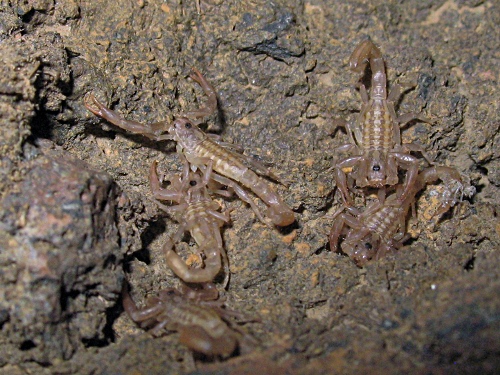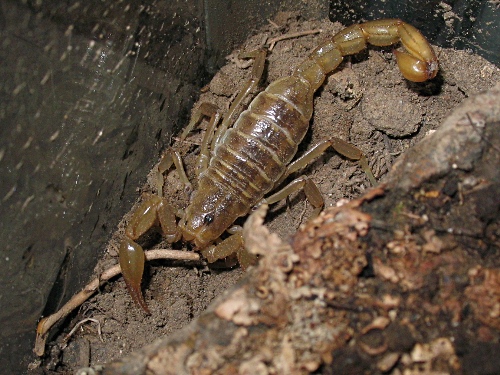

A few days after we had arrived in our new house in Coatepec a female scorpions I suspected to be gravid - she had mated over a year ago with a male of the same species - was no longer visible. I even couldn't find her under a large stone, her favorite hiding place. Nor could I see the entry of a burrow, and no traces of her or a burrow under smaller stones. I didn't check under one stone, because it was deeper in the substrate than the others.
The past weeks I had been inspecting several times the terrarium. I also had carefully lifted the terrarium, expecting to see her burrow through the other sides or the bottom. In the past I had been able to see the scorpion babies of the same species that way, but not this time.
The female scorpion, as far as I know species Vaejovis punctatus, was captured four years ago on the the rim of the crater that holds the water body called Laguna de Alchichica as a juvenile. Based on my experience with this species I guess that the juvenile back then was between 6 months and one year old.
And just after midnight of the 21st of April, 2008, I let her mate with a male of the same species, which turned out to be very successful, maybe because the actual insemination took place upside down. But I run ahead of the story.
Today I again inspected the terrarium. And after I had lifted the largest stone, I decided to also check the smaller stones. And I started with the stone I had avoided those past weeks because it was deeper in the substrate than any of the others. Somehow I had forgotten the rule I had set: don't lift that one, because if she's underneath, the burrow might collapse.

But when I realized my mistake I saw a much thinner scorpion run away, and then I spotted several tiny (5-6 mm) scorpions crawling on the underside of the stone. So I grabbed my Canon A640 and took two pictures. After I had taken the pictures I carefully placed the stone back in place and misted the substrate a little.

Some of the little scorpions started to wander on the now moist substrate, and a little later I saw one drinking moisture from the glass. And shortly after I noticed the mother scorpion digging a new burrow under one of the smaller stones. Or actually at that moment she was dragging a piece of dead plant material out of the start of a burrow using her chelicerae (mouth parts) of which I tried to take a photo, but I was just too late. In the photo below you can see the piece of dead plant material close to the mouth of the scorpion.

Sadly, last Wednesday I discovered that the small gray snake I kept, a Conopsis lineata, had died. Since its terrarium uses the same substrate as I use for the Vaejovis cf. punctatus I am going to use its terrarium to house the mother and the babies later on. Instead of isolating the babies, which I tried with this species in the past resulting in only one survivor, I want to try to provide a relatively large space with many hiding places - most scorpions have no problem to eat each other - to see if more will survive that way.